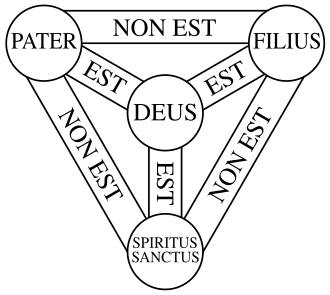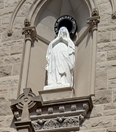Holy Trinity
Appearance
The "Trinity" or, "Holy Trinity" of the Father, the Son, and the Holy Spirit
- note: see glossary entry on "Holy"
The Holy Trinity is called collectively the "Godhead" or the "Triune"
- also, the "Blessed Trinity"
Terminology of the Trinity[edit | edit source]
Godhead[edit | edit source]
The Trinity may also be referred to as the "Godhead"
- = God in the full nature of the Trinity
- from Middle English God + hede (nature of)
- note: the Father is the "source and origin" of the Godhead, but the Godhead indivisibly consists of the Father, the Son and the Holy Spirit
- see CCC 2789
hypostasis[edit | edit source]
refers to the "Persons" of God; in Latin persona
- from Greek for "substance"
- from hypo- (under) + stasis (standing or position)
- hypostasis is singular for "Person"
- hypostases is plural for "Persons"
hypostatic union[edit | edit source]
refers to the "union of the divine and human natures... of the Son of God, Jesus Christ" (CCC Glossary)
- i.e. that Jesus Christ was fully human and fully divine
Triune[edit | edit source]
a similar reference to "Godhead" for the Holy Trinity
- but also used as an adjective, as in "the Triune God"
Athanasian Creed[edit | edit source]
or Quicunque vult
- an important early Church statement and explanation of the Holy Trinity
- from from CCC 266
"Now this is the Catholic faith: We worship one God in the Trinity and the Trinity in unity, without either confusing the persons or dividing the substance; for the person of the Father is one, the Son's is another, the Holy Spirit's another; but the Godhead of the Father, Son and Holy Spirit is one, their glory equal, their majesty coeternal" (Athanasian Creed: DS 75; ND 16).
- See
- entry on Athanasian Creed
- The "Athanasian" Creed (slightly different translation from EWTN)
The Trinity[edit | edit source]
The Holy Trinity is the mystery of God in three Persons: Father, Son, and Holy Spirit
- the Trinisy consists of the
- Persons of God: Father Son and Holy Spirit
- Natures of God: Creator, Redeemer, and Sanctifier
- the Trinity was source of much conflict and contention in the early Church
- and, ultimately, a core tenant of Church doctrine
- Jews were offended that fellow Jews worshiped Christ, as Judaism was supposed to be monotheistic
- Romans considered Christians atheistic, as they rejected Roman gods and refused to worship Caesar
- gnostics and other heretics believed that Jesus fully God and not a Man, thus he was either not a man or not God
Shield of the Trinity (Scutum Fidei)[edit | edit source]


- derived from the Athanasian Creed
- God (DEUS) is at the center
- the three Persons are at the corners
- the shiled was consiered the "Herald of God"
The forumulation of the Shield[edit | edit source]
- note that all the links (connections) are bi-directional (go both ways)
- EST means "is"
- NON EST means "is not"
Thereby:
- "The Father is God"
- "The Son is God"
- "The Holy Spirit is God"
- "God is the Father"
- "God is the Son"
- "God is the Holy Spirit"
- "The Father is not the Son"
- "The Father is not the Holy Spirit"
- "The Son is not the Father"
- "The Son is not the Holy Spirit"
- "The Holy Spirit is not the Father"
- "The Holy Spirit is not the Son"
St. Thomas Aquinas on the Trinity[edit | edit source]
St. Thomas Aquinas thought deeply about the Trinity in Summa Theologica
- his thought extends from the concepts of the Trinity and the Oneness of God:
- One God
- Two Processions
- The Father > The Son (Generation)
- The Father and The Son > Holy Spirit (Spiration)
- Three Persons
- The Father
- The Son
- The Holy Spirit
- Four Relations
- The Father > The Son = Paternity
- The Son < The Father = Filiation
- The Father and The Son > The Holy Spirit = Active Spiration (originiation)
- The Father and The Son < The Holy Spirit = Passive Spiration (procession)
- Five Notions
- The Father > innascibility or unbegottennes
- The Father > paternity, i.e. The Father > The Son
- The Father and The Son "spirate" the Holy Spirit
- The Son = both Filiation and Spiration
- The Holy Spirit = Procession
- notes:
- St. Thomas wrote in Summa Theologica,
- "Although there are four relations in God, one of them, spiration, is not separated from the person of the Father and of the Son, but belongs to both;"
- these relations, originatinos, and processions are internal to God and not related to temporal process (outside of time)
- See:
- St. Thomas wrote in Summa Theologica,
